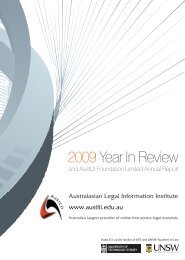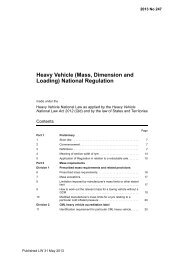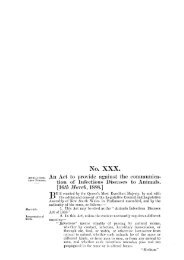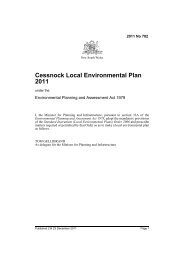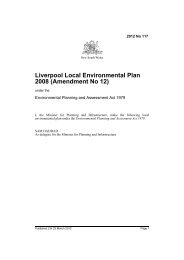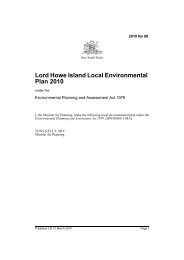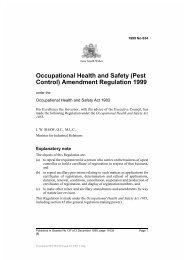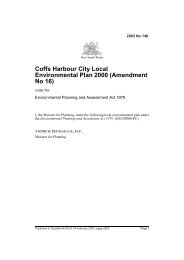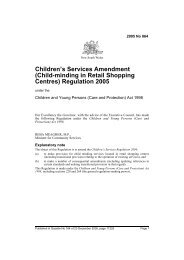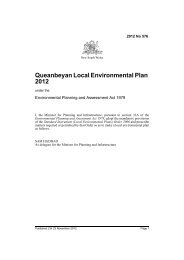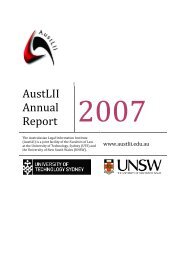Electricity (Overhead Line Safety) Regulation 1991
Electricity (Overhead Line Safety) Regulation 1991
Electricity (Overhead Line Safety) Regulation 1991
You also want an ePaper? Increase the reach of your titles
YUMPU automatically turns print PDFs into web optimized ePapers that Google loves.
ELECTRICITY ACT 1945—REGULATION<br />
(<strong>Electricity</strong> (<strong>Overhead</strong> <strong>Line</strong> <strong>Safety</strong>) <strong>Regulation</strong> <strong>1991</strong>)<br />
NEW SOUTH WALES<br />
<strong>1991</strong>—No. 412<br />
[Published in Gazette No. 114 of 9 August <strong>1991</strong>]<br />
HIS Excellency the Governor, with the advice of the Executive Council,<br />
and in pursuance of the <strong>Electricity</strong> Act 1945, has been pleased to make<br />
the <strong>Regulation</strong> set forth hereunder.<br />
ROBERT WEBSTER<br />
Minister for Energy.<br />
Citation<br />
1. This <strong>Regulation</strong> may be cited as the <strong>Electricity</strong> (<strong>Overhead</strong> <strong>Line</strong><br />
<strong>Safety</strong>) <strong>Regulation</strong> <strong>1991</strong>.<br />
Commencement<br />
2. This <strong>Regulation</strong> commences on 1st September, <strong>1991</strong>.<br />
Repeal<br />
3. The <strong>Overhead</strong> <strong>Line</strong> Construction and Maintenance <strong>Regulation</strong>s<br />
1962 are repealed.<br />
Definitions<br />
PART 1—PRELIMINARY<br />
4. In this <strong>Regulation</strong>:<br />
“active conductor” means any one of those conductors of an<br />
electricity supply system which is maintained at a difference of<br />
potential from the neutral or earthed conductor and, in relation to a<br />
system which does not contain a neutral or earthed conductor,<br />
includes all conductors of the system;
2<br />
<strong>1991</strong>—No. 412<br />
“aerial conductor” means any conductor which is placed above the<br />
ground, in the open air, and is suspended between 2 or more<br />
supports;<br />
“ bare” , in relation to a conductor, means not insulated;<br />
“carriageway” means:<br />
(a) that portion of a public road which is improved or designed<br />
for use by, or used by, vehicular traffic, including any road<br />
shoulder and breakdown lane but not including any footpath<br />
or other lateral part of the road not so improved, designed or<br />
used; or<br />
(b) that portion of a defined vehicular track (whether formed or<br />
unformed) which is ordinarily used by the public and which<br />
is located on a road reserve or on land under the control of<br />
the Western Lands Commissioner or in a national park,<br />
State forest or other Crown land, and includes the entire<br />
width of the defined vehicular track plus 2.5 metres on each<br />
side of the track;<br />
“conductor” means any wire or cable used or placed in position for<br />
the conveyance of electricity;<br />
“consumer’s aerial line” means an overhead line operating at a<br />
voltage lower than 650 volts and being part of a consumer’s<br />
installation;<br />
“consumer’s installation” means all the electric wires, cables,<br />
appliances, fittings, insulators and apparatus installed in, on, under<br />
or over any premises and used for, or for purposes incidental to, the<br />
conveyance, measurement, control or use of electricity supplied or<br />
intended to be supplied by an electricity supply authority, but does<br />
not include:<br />
(a) any electricity supply main or service line, meter or<br />
apparatus the property of an electricity supply authority and<br />
used solely for the conveyance, measurement or control of<br />
electricity supplied to any premises; and<br />
(b) any movable electrical equipment;<br />
“Corporation” means the Energy Corporation of New South Wales<br />
constituted under the Energy Administration Act 1987;<br />
“earthed” means electrically connected to the general mass of earth;<br />
“insulated” , in relation to an overhead line, means provided with<br />
insulation material of the appropriate grade for the voltage at which<br />
the overhead line is or is to be operated;
3<br />
<strong>1991</strong>—No. 412<br />
“overhead line” means any aerial conductor or conductors with<br />
associated supports, insulators and other apparatus erected for the<br />
purpose of the transmission, distribution or conveyance of<br />
electricity;<br />
“overhead service line” means an overhead line operating at a<br />
voltage lower than 650 volts located between an electricity supply<br />
authority’s mains and the point of attachment to a consumer’s<br />
ins tallation;<br />
“point of attachment” means the point at which aerial conductors of<br />
an overhead service line or consumer’s aerial line are terminated on<br />
a consumer’s building, pole or structure;<br />
“point of entry” means the point at which the consumer’s mains<br />
enter a building or appurtenance of a building;<br />
“road” means a public thoroughfare ordinarily used by motor<br />
vehicles or, in the case of land under the control of the Western<br />
Lands Commissioner, or in a national park, State forest or other<br />
Crown land, means a defined vehicular track, whether formed or<br />
uniformed, ordinarily used by the public;<br />
“support” means the total structural system used to support an<br />
overhead line at a particular location and includes elements such as<br />
foundations, poles, steelwork, stays, struts, crossarms and fittings;<br />
“voltage” means the nominal difference of potential between active<br />
conductors, or the nominal difference of potential between an active<br />
conductor and ground multiplied by the square root of 3, whichever<br />
is the greater.<br />
Scope and application<br />
5. (1) This <strong>Regulation</strong>, except where otherwise expressly provided,<br />
applies to all overhead lines other than the following:<br />
(a) overhead lines forming part of an overhead traction contact<br />
system or associated feeder when carried on the contact system<br />
supports;<br />
(b) an overhead line operating at a voltage not exceeding 32 volts<br />
alternating current or 115 volts direct current;<br />
(c) an overhead line to which the Coal Mines <strong>Regulation</strong> Act 1982, or<br />
any rules or regulations made under that Act, apply or to which<br />
the Mines Inspection Act 1901, or any rules made under that Act,<br />
apply;<br />
(d) any pat of an overhead line which is within the boundaries of a<br />
fence of enclosure preventing ready access by unauthorised<br />
persons and which is used for the purpose of connection to a<br />
ground-type substation, regulating station or the like;
4<br />
<strong>1991</strong>—No. 412<br />
(e) an overhead line .operating at a voltage lower than 650 volts,<br />
constructed in accordance with the relevant S.A.A. Wiring Rules<br />
(within the meaning of the Consumers Electrical Installations<br />
(<strong>Safety</strong>) <strong>Regulation</strong>s 1961), which forms part of a consumer’s<br />
installation and has been installed in accordance with those<br />
<strong>Regulation</strong>s;<br />
(f) an overhead line or any section of an overhead line which is out<br />
of service for maintenance or upgrading;<br />
(g) an overhead line or any section of an overhead line which is under<br />
construction and not yet placed into service.<br />
(2) Despite subclause (1) (d), the requirements of clause 22 (3) apply<br />
to protective devices associated with an overhead line even if the devices<br />
are located within a ground-type substation, regulating station or the like.<br />
Crown bound<br />
6. This <strong>Regulation</strong> binds the Crown.<br />
Special exemptions<br />
7. The Corporation may by instrument in writing exempt the owner of<br />
an overhead line from complying with any provision of this <strong>Regulation</strong><br />
and may impose conditions on the exemption.<br />
Unsafe of hazardous work<br />
8. (1) Despite any other provision of this <strong>Regulation</strong>, the Corporation<br />
may direct that an overhead line, or part of an overhead line, to which this<br />
<strong>Regulation</strong> applies that it thinks is unsafe or hazardous be disconnected,<br />
removed, repaired or made safe to the satisfaction of and in the manner<br />
and within the time specified by the Corporation.<br />
(2) Such a direction is to be given in writing to the owner of the<br />
overhead line concerned.<br />
PART 2—SAFETY REQUIREMENTS FOR THE DESIGN AND<br />
CONSTRUCTION OF NEW OVERHEAD LINES<br />
Application<br />
9. Except as provided by clauses 5 and 7, this Part applies:<br />
(a) to all overhead lines placed into service on or after the<br />
commencement of this <strong>Regulation</strong> (other than overhead lines to<br />
which Part 3 applies); and
5<br />
<strong>1991</strong>—No. 412<br />
(b) to any part of an overhead line which is upgraded, renewed or<br />
replaced after that commencement.<br />
Insulated conductors<br />
10. (1) The maximum temperature at which any insulated aerial<br />
conductor is designed to operate, having regard to its required current<br />
loading (excluding fault currents) and to the climatic conditions likely to<br />
be experienced, must not be such as to cause damage to any insulation<br />
sufficient to cause injury from electric shock to any person or damage to<br />
property.<br />
(2) Every aerial active conductor of an overhead service line or<br />
consumer’s aerial line, if terminating on a building or appurtenance to a<br />
building, must be insulated between the last pole and the point of<br />
attachment on the building or appurtenance, including the connection to<br />
the consumer’s installation.<br />
Loading conditions<br />
11. (1) Calculation of the stresses to which supports, insulators and<br />
conductors may be subjected must take into account the conditions likely<br />
to be experienced in service so as to prevent failure, as far as is<br />
reasonably practicable, of those components.<br />
(2) An insulated overhead service line or consumer’s aerial line is not<br />
to be attached to a building or appurtenance to a building unless a point<br />
of attachment capable of withstanding, without damage, any loads to<br />
which it may be subjected under design conditions has been provided.<br />
Earthing of supports<br />
12. (1) All portions of supports or attachments to supports which form<br />
part of an overhead line and are capable of being touched by a person<br />
without the use of a ladder or other device to assist access, and which<br />
might reasonably be expected to become energised from the electricity<br />
supply system in the event of failure of insulation or contact with a<br />
conductor, must be earthed, insulated or enclosed in such a manner as to<br />
prevent, so far as is reasonably practicable, any injury arising from the<br />
presence of a voltage gradient between earth and the support or<br />
attachment.<br />
(2) All earthing conductors which connect any part of an overhead line<br />
to the earth must be protected from mechanical damage from ground level<br />
to a height not less than 1.8 metres above ground level.
Location of point of attachment<br />
6<br />
<strong>1991</strong>—No. 412<br />
13. The position of the point of attachment must not be normally<br />
accessible to any person without the use of a ladder or other device to<br />
assist climbing.<br />
Prevention of unauthorised access<br />
14. The owner of an overhead line, where the circumstances<br />
reasonably require, must fit suitable devices or undertake effective<br />
measures to prevent, so far as is reasonably practicable, access (other than<br />
access obtained by the use of a ladder or other device) by any member of<br />
the public to a position near any live aerial conductor or apparatus, where<br />
injury from electric shock may be possible.<br />
Clearances of conductors from ground<br />
15. (1) The aerial conductors of an overhead line (other than insulated<br />
aerial conductors of an overhead service line) must be so located that,<br />
when operating at the voltage specified in Column 1 of Table A, the<br />
distances to ground in any direction, from any position to which any part<br />
of such conductors may sag under operational conditions (excluding fault<br />
currents or emergency load currents), are not less than the distances<br />
specified in Columns 2, 3 and 4 of Table A in relation to that voltage.<br />
Column 1<br />
Column 2 Column 3 Column 4<br />
Distances to ground in any direction<br />
Voltage<br />
Over a<br />
carriageway<br />
Over land<br />
other than a<br />
carriageway<br />
or land<br />
described in<br />
Column 4<br />
Over land<br />
which due to<br />
its steepness<br />
or<br />
swampiness<br />
of terrain<br />
cannot be<br />
traversed by<br />
traffic or<br />
mobile<br />
machinery<br />
Bare or insulated conductor not<br />
exceeding 650 volts or any insulated<br />
and earthed screened conductor<br />
exceeding 650 volts<br />
5.5 metres<br />
5.5 metres<br />
4.5 metres
7<br />
<strong>1991</strong>—No. 412<br />
TABLE A—CLEARANCES OF CONDUCTORS FROM GROUND—continued<br />
Column 1 Column 2 Column 3 Column 4<br />
Voltage<br />
Bare conductor exceeding 650 volts but<br />
not exceeding 33,000 volts or<br />
insulated conductor exceeding 650<br />
volts<br />
Distances to ground in any direction<br />
Over a<br />
carriageway<br />
6.7 metres<br />
Bare conductor exceeding 33,000 volts 6.7 metres<br />
but not exceeding 132,000 volts<br />
Bare conductor exceeding 132,000 volts<br />
but not exceeding 220,000 volts<br />
Bare conductor exceeding 220,000 volts<br />
but not exceeding 330,000 volts<br />
Bare conductor exceeding 330,000 volts<br />
but not exceeding 500,000 volts<br />
Over land<br />
other than a<br />
carriageway<br />
or land<br />
described in<br />
Column 4<br />
Over land<br />
which due to<br />
its steepness<br />
or<br />
swampiness<br />
of terrain<br />
cannot be<br />
traversed by<br />
traffic or<br />
mobile<br />
machinery<br />
5.5 metres 4.5 metres<br />
6.7 metres 5.5 metres<br />
7.5 metres 7.5 metres 6.0 metres<br />
8.0 metres 8.0 metres 6.7 metres<br />
9.0 metres 9.0 metres 7.5 metres<br />
(2) The insulated aerial conductors of an overhead service line must be<br />
so located that the distances to ground in any direction from any position<br />
to which any part of such conductors may sag under operational<br />
conditions (excluding fault currents or emergency load currents) are not<br />
less than the distances specified. in Table B.<br />
TABLE B—CLEARANCES OF INSULATED OVERHEAD SERVICE LINES<br />
FROM GROUND<br />
Location<br />
Over the centre of a carriageway<br />
Over any part of a carriageway (other than the centre)<br />
Distances to ground in<br />
any direction<br />
5.5 metres<br />
4.9 metres
8<br />
<strong>1991</strong>—No. 412<br />
TABLE B—CLEARANCES OF INSULATED OVERHEAD SERVICE LINES<br />
FROM GROUND—continued<br />
Location<br />
Over a vehicular crossing of a footway (other than a<br />
residential driveway)<br />
Over land (other than land associated with a dwelling<br />
which is, or is likely to be, used by vehicles)<br />
Over a vehicular crossing of a footway associated<br />
with a residential driveway and over any portion of<br />
a footway<br />
Over land which is, or is likely to be, used by vehicles<br />
and is associated with a dwelling<br />
Elsewhere<br />
Distances to ground in<br />
any direction<br />
4.5 metres<br />
4.5 metres<br />
3.0 metres<br />
3.0 metres<br />
2.7 metres<br />
(3) <strong>Overhead</strong> lines erected above land which has undergone a change<br />
of use which v varies the application of subclause (1) or (2) must be<br />
reconstructed in accordance with the requirements of those subclauses.<br />
Clearances of conductors from structures<br />
16. The aerial conductors of an overhead line must be so located away<br />
from structures or parts of structures that the swing or sag of the<br />
conductors under operational conditions (excluding fault currents or<br />
emergency load currents) is not such as to cause injury from electric<br />
shock to any person or damage to property.<br />
Arrangement and separation of aerial conductors<br />
17. (1) Where aerial conductors, the voltage of which does not exceed<br />
650 volts, are carried on the same pole or support as those of a higher<br />
voltage, the lower voltage conductors must be placed below the higher<br />
voltage conductors.<br />
(2) Subclause (1) does not apply to:<br />
(a) insulated pilot cables erected for the purpose of protection or<br />
telecommunication; or<br />
(b) insulated cables for auxiliary power supplies; or<br />
(c) overhead earth wires; or<br />
(d) insulated and earthed screened conductors.
9<br />
<strong>1991</strong>—No. 412<br />
(3) Any 2 bare aerial conductors carried on the same poles or supports<br />
or on separate poles or supports and having a difference in voltage with<br />
respect to each other, must have adequate, as far as is reasonably<br />
practicable, vertical, horizontal or angular separation from each other to<br />
prevent the conductors coming into contact with or within arcing distance<br />
of each other.<br />
Automatic de-energisation of conductors under fault conditions<br />
18. Aerial conductors of an overhead line must, where reasonably<br />
practicable, be automatically de-energised under permanent fault<br />
conditions.<br />
PART 3—SAFETY REQUIREMENTS FOR EXISTING<br />
OVERHEAD LINES<br />
Application<br />
19. Except as provided by clauses 5 and 7, this Part applies to all<br />
existing overhead lines, being:<br />
(a) overhead lines placed into service before the date of<br />
commencement of this <strong>Regulation</strong>; or<br />
(b) overhead lines, designed and constructed in accordance with the<br />
<strong>Overhead</strong> <strong>Line</strong> Construction and Maintenance <strong>Regulation</strong>s 1962,<br />
as in force immediately before the commencement of this<br />
<strong>Regulation</strong>, and placed into service within 6 months after the<br />
commencement of this <strong>Regulation</strong>.<br />
Compliance with regulations<br />
20. (1) All existing overhead lines must comply with:<br />
(a) Part 2; or<br />
(b) the law relating to their construction that was in force at the time<br />
of the erection of such lines or placing of such lines into service,<br />
and with subclauses (2)—(4).<br />
(2) Where any land above which overhead lines have been erected<br />
undergoes a change of use that varies the application of ground clearances<br />
specified by the law relating to their construction, the portions of those<br />
overhead lines which are situated over the land must be reconstructed in<br />
accordance with the requirements of clause 15 (1) and (2).
10<br />
<strong>1991</strong>—No. 412<br />
(3) Every bare aerial active conductor of an overhead service line or<br />
consumer’s aerial line terminating on a building or appurtenance to a<br />
building must be insulated between the last pole and the point of<br />
attachment on the building or appurtenance, including the connection to<br />
the consumer’s installation.<br />
(4) The owner of an overhead line, where the circumstances reasonably<br />
require, must fit suitable devices or undertake effective measures to<br />
prevent, as far as is practicable, access (other than access obtained by the<br />
use of a ladder or other device) by any member of the public to a position<br />
near any live aerial conductor or apparatus, where injury from electric<br />
shock may be possible.<br />
(5) For the purposes of subclause (3), covered conductors complying<br />
with A.S. No. C.306-1958 (Australian Standards Code—specification for<br />
bare and covered hard-drawn copper conductors (for overhead lines)) or<br />
BS 6485:1971 (British Standards specification for PVC-covered<br />
conductors for overhead power lines) and erected before 8 July 1987 are<br />
to be regarded as insulated.<br />
Application<br />
PART 4—MAINTENANCE REQUIREMENTS FOR ALL<br />
OVERHEAD LINES<br />
21. Except as provided by clauses 5 and 7, this Part applies to all<br />
overhead lines, whether placed in service before, on or after the<br />
commencement of this <strong>Regulation</strong>.<br />
Maintenance of lines and fittings<br />
22. (1) A11 overhead lines, including earthing conductors, electrodes<br />
and clamps associated with an overhead line, must be periodically<br />
inspected and, if considered necessary, tested and must be maintained in<br />
proper working order.<br />
(2) The integrity of insulation of overhead service lines and consumers’<br />
aerial lines must be maintained in the vicinity of the point of entry or<br />
adjacent to roofs or structures, which, while not normally accessible to<br />
persons, may become accessible under certain circumstances and result in<br />
contact by persons with the insulated service wires, service loops or<br />
connectors.
11<br />
<strong>1991</strong>—No. 412<br />
(3) All protective devices, including fuses, automatic reclosing circuit<br />
breakers, protection relays or the like, provided to operate in conjunction<br />
with the requirements of clause 12 (1) or 18, must be periodically<br />
inspected and, if considered necessary, tested and must be maintained in<br />
proper working order.<br />
Avoidance of contact between trees and aerial conductors<br />
23. (1) Where contact between any aerial conductor of an overhead<br />
line and any tree or flora might reasonably be expected to result in<br />
consequential injury from electric shock to any person or damage to<br />
property, the owner of the line must ensure that the tree or flora is<br />
trimmed or other measures are taken to prevent contact with the aerial<br />
conductor.<br />
(2) If tree trimming is undertaken, provision must be made for the<br />
expected regrowth of trees or flora prior to the next planned inspection.<br />
Clearance to ground and structures<br />
24. All overhead lines must be periodically inspected and must be<br />
maintained to ensure that the clearances to ground and structures are not<br />
less than those prescribed by Part 2 and Part 3.<br />
Disused lines<br />
25. If an overhead line has ceased to be used for the conveyance of<br />
electricity, the owner of the line must dismantle it as soon as is<br />
reasonably practicable or continue to maintain it in accordance with this<br />
<strong>Regulation</strong>.<br />
Penalties<br />
PART 5—OFFENCES<br />
26. Any person who:<br />
(a) being the owner of an overhead line, places into service a new,<br />
upgraded, renewed or replaced section or part of an overhead line<br />
to which Part 2 applies which does not comply with the<br />
requirements of that Part; or<br />
(b) being the owner of an overhead line to which Part 3 applies, fails<br />
to comply with the requirements of that Part; or<br />
(c) being the owner of an overhead line to which Part 4 applies, fails<br />
to maintain the overhead line in accordance with that Part; or
12<br />
<strong>1991</strong>—No. 412<br />
(d) being the owner of an overhead line, fails to comply with any<br />
condition of an exemption relating to the overhead line under<br />
clause 7; or<br />
(e) being the owner of an overhead line, fails to carry out a direction<br />
of the Corporation under clause 8 to the satisfaction of and in the<br />
manner and within the time specified by the Corporation; or<br />
(f) not being the owner of an overhead line, seeks to gain access by<br />
the use of a ladder or other device, without the authority of the<br />
owner, to any position near any live aerial conductor or apparatus,<br />
where injury from electric shock may be possible,<br />
is guilty of an offence and liable to a penalty not exceeding $2,000 and<br />
also a daily penalty not exceeding $200 for any continuing offence.<br />
1.<br />
2.<br />
3.<br />
4.<br />
5.<br />
6.<br />
7.<br />
8.<br />
9.<br />
10.<br />
11.<br />
12.<br />
13.<br />
14.<br />
15.<br />
16.<br />
17.<br />
18.<br />
19.<br />
20.<br />
NOTES<br />
TABLE OF PROVISIONS<br />
PART 1—PRELIMINARY<br />
Citation<br />
Commencement<br />
Repeal<br />
Definitions<br />
Scope and application<br />
Crown bound<br />
Special exemptions<br />
Unsafe or hazardous work<br />
PART 2—SAFETY REQUIRMENTS FOR THE DESIGN AND<br />
CONSTRUCTION OF NEW OVERHEAD LINES<br />
Application<br />
Insulated conductors<br />
Loading conditions<br />
Earthing of suppOrts<br />
Location of point of attachment<br />
Prevention of unauthorised access<br />
Clearances of conductors from ground<br />
Clearances of conductors from structures<br />
Arrangement and separation of aerial conductors<br />
Automatic de-energisation of conductors under fault conditions<br />
PART 3—SAFETY REQUIREMENTS FOR EXISTING OVERHEAD<br />
LINES<br />
Application<br />
Compliance with regulations
13<br />
<strong>1991</strong>—No. 412<br />
21.<br />
22.<br />
23.<br />
24.<br />
25.<br />
PART 4—MAINTENANCE REQUIREMENTS FOR ALL OVERHEAD<br />
LINES<br />
Application<br />
Maintenance of lines and fittings<br />
Avoidance of contact between trees and aerial conductors<br />
Clearance to ground and structures<br />
Disused lines<br />
PART 5—OFFENCES<br />
26. Penalties<br />
EXPLANATORY NOTE<br />
The object of this <strong>Regulation</strong> is to repeal the <strong>Overhead</strong> <strong>Line</strong> Construction and<br />
Maintenance <strong>Regulation</strong>s 1962 and to replace those <strong>Regulation</strong>s with a new<br />
<strong>Regulation</strong> which deals with the same subject-matter, namely, the safety<br />
requirements relating to the erection and maintenance of certain overhead lines.<br />
The <strong>Regulation</strong> is divided as follows:<br />
Part 1—Preliminary—contains definitions, specifies the overhead lines to<br />
which the <strong>Regulation</strong> applies, enables the Energy Corporation to grant exemptions<br />
and give directions and states that the <strong>Regulation</strong> binds the Crown.<br />
Part 2—<strong>Safety</strong> Requirements for the Design and Construction of New<br />
<strong>Overhead</strong> <strong>Line</strong>s—places obligations on the owners of such lines to comply with<br />
specified safety requirements.<br />
Part 3—<strong>Safety</strong> Requirements for Existing <strong>Overhead</strong> <strong>Line</strong>s—places obligations<br />
on the owners of such lines to comply with specified safety requirements.<br />
Part 4—Maintenance Requirements for All <strong>Overhead</strong> <strong>Line</strong>s—places<br />
obligations on the owners of such lines to ensue that the lines are maintained in<br />
accordance with specified safety requirements.<br />
Part 5—Offences—makes it an offence for the owner of an overhead line not<br />
to comply with the <strong>Regulation</strong> or the term of an exemption or direction given<br />
under the <strong>Regulation</strong> or for the person to gain unauthorised access to certain parts of<br />
overhead lines and specifies a maximum penalty for the offence of $2,000 and $200<br />
for each day such an offence continues.



